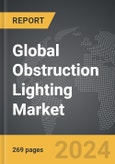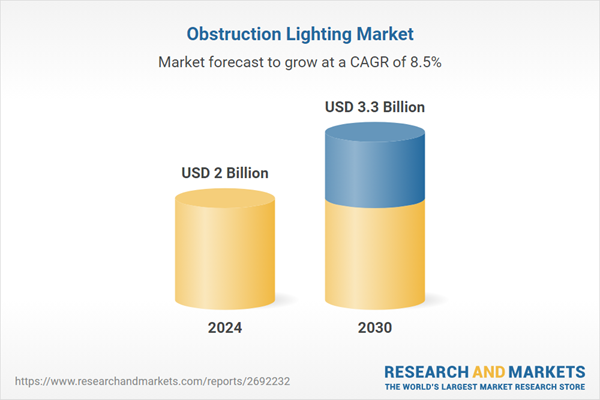The global market for Obstruction Lighting was valued at US$2 Billion in 2024 and is projected to reach US$3.3 Billion by 2030, growing at a CAGR of 8.5% from 2024 to 2030. This comprehensive report provides an in-depth analysis of market trends, drivers, and forecasts, helping you make informed business decisions.
The types of aviation obstruction lights vary based on the structure's height and the required visibility range. Low-intensity obstruction lights, which provide a constant source of light, are suitable for structures under 147.6 feet. Medium-intensity lights, which flash red or white, are used for structures between approximately 344 feet and 492 feet, helping to mark their presence more distinctly against the urban backdrop. High-intensity obstruction lights, required for structures over 500 feet, ensure visibility from greater distances, safeguarding air traffic by outlining the structures' forms more clearly, which helps pilots gauge their proximity and maneuver safely. Proper placement of these lights is crucial - they must be installed in a configuration that provides visibility from all angles, ensuring that the structure's dimensions and boundaries are clearly marked to aid navigation.
Obstruction lighting is also mandated for certain industries, such as broadcasting, where structures like broadcast towers often exceed the height regulations set by aviation authorities. These regulations are not just bureaucratic formalities but are critical safety measures. Failure to comply can result in severe legal and financial repercussions, including substantial fines. Beyond compliance, obstruction lighting is vital for ensuring the operational continuity of services such as broadcasting, where tower functionality directly affects service reliability. Broadcasting companies, therefore, view these lights as essential investments to maintain uninterrupted transmission and uphold consumer trust. The broader market for obstruction lighting is also driven by several factors, including global infrastructure growth, advancements in LED technology, increasing air traffic, and heightened public safety awareness. These factors underscore the comprehensive role of obstruction lighting in enhancing safety across various industries, not only in aviation but also in maritime and coastal applications, making it an indispensable component of modern structural planning and safety protocols.
Global Obstruction Lighting Market - Key Trends and Drivers Summarized
Aviation obstruction lights, essential for enhancing the safety of air navigation, have become increasingly critical with the growth of air travel and the construction of high structures. These lights, which are vital for aiding pilots in identifying and avoiding tall structures during poor visibility conditions or at night, are installed on various infrastructures such as buildings, towers, and tall fences, especially those located in low-flying zones. The primary function of these lights is to ensure they are visible from several miles away, thereby significantly enhancing the safety of aircraft by illuminating structures that could pose navigational hazards. The Federal Aviation Administration (FAA) and the International Civil Aviation Organization (ICAO) mandate that any structure exceeding 200 feet in height be equipped with these lights, and they have set strict standards regarding the intensity, color, beam pattern, and number of lights required.The types of aviation obstruction lights vary based on the structure's height and the required visibility range. Low-intensity obstruction lights, which provide a constant source of light, are suitable for structures under 147.6 feet. Medium-intensity lights, which flash red or white, are used for structures between approximately 344 feet and 492 feet, helping to mark their presence more distinctly against the urban backdrop. High-intensity obstruction lights, required for structures over 500 feet, ensure visibility from greater distances, safeguarding air traffic by outlining the structures' forms more clearly, which helps pilots gauge their proximity and maneuver safely. Proper placement of these lights is crucial - they must be installed in a configuration that provides visibility from all angles, ensuring that the structure's dimensions and boundaries are clearly marked to aid navigation.
Obstruction lighting is also mandated for certain industries, such as broadcasting, where structures like broadcast towers often exceed the height regulations set by aviation authorities. These regulations are not just bureaucratic formalities but are critical safety measures. Failure to comply can result in severe legal and financial repercussions, including substantial fines. Beyond compliance, obstruction lighting is vital for ensuring the operational continuity of services such as broadcasting, where tower functionality directly affects service reliability. Broadcasting companies, therefore, view these lights as essential investments to maintain uninterrupted transmission and uphold consumer trust. The broader market for obstruction lighting is also driven by several factors, including global infrastructure growth, advancements in LED technology, increasing air traffic, and heightened public safety awareness. These factors underscore the comprehensive role of obstruction lighting in enhancing safety across various industries, not only in aviation but also in maritime and coastal applications, making it an indispensable component of modern structural planning and safety protocols.
Report Scope
The report analyzes the Obstruction Lighting market, presented in terms of market value (USD). The analysis covers the key segments and geographic regions outlined below.Segments
Application (Buildings & Structures, Telecommunications, Aviation & Aerospace, Energy).Geographic Regions/Countries
World; United States; Canada; Japan; China; Europe (France; Germany; Italy; United Kingdom; and Rest of Europe); Asia-Pacific; Rest of World.Key Insights:
- Market Growth: Understand the significant growth trajectory of the Buildings & Structures Application segment, which is expected to reach US$1.5 Billion by 2030 with a CAGR of a 7.8%. The Telecommunications Application segment is also set to grow at 10.2% CAGR over the analysis period.
- Regional Analysis: Gain insights into the U.S. market, valued at $561.5 Million in 2024, and China, forecasted to grow at an impressive 7.9% CAGR to reach $506.1 Million by 2030. Discover growth trends in other key regions, including Japan, Canada, Germany, and the Asia-Pacific.
Why You Should Buy This Report:
- Detailed Market Analysis: Access a thorough analysis of the Global Obstruction Lighting Market, covering all major geographic regions and market segments.
- Competitive Insights: Get an overview of the competitive landscape, including the market presence of major players across different geographies.
- Future Trends and Drivers: Understand the key trends and drivers shaping the future of the Global Obstruction Lighting Market.
- Actionable Insights: Benefit from actionable insights that can help you identify new revenue opportunities and make strategic business decisions.
Key Questions Answered:
- How is the Global Obstruction Lighting Market expected to evolve by 2030?
- What are the main drivers and restraints affecting the market?
- Which market segments will grow the most over the forecast period?
- How will market shares for different regions and segments change by 2030?
- Who are the leading players in the market, and what are their prospects?
Report Features:
- Comprehensive Market Data: Independent analysis of annual sales and market forecasts in US$ Million from 2024 to 2030.
- In-Depth Regional Analysis: Detailed insights into key markets, including the U.S., China, Japan, Canada, Europe, Asia-Pacific, Latin America, Middle East, and Africa.
- Company Profiles: Coverage of players such as Astronics Corporation, Avlite Systems, Carmanah Technologies Corporation, Dialight PLC, Dialight plc and more.
- Complimentary Updates: Receive free report updates for one year to keep you informed of the latest market developments.
Some of the 13 companies featured in this Obstruction Lighting market report include:
- Astronics Corporation
- Avlite Systems
- Carmanah Technologies Corporation
- Dialight PLC
- Dialight plc
- K-LITE Industries
- Pfannenberg, Inc.
- SPX Corporation
- UNIMAR, Inc.
- WERMA Signaltechnik GmbH + Co.KG
Table of Contents
I. METHODOLOGYII. EXECUTIVE SUMMARY2. FOCUS ON SELECT PLAYERSIII. MARKET ANALYSISIV. COMPETITION
1. MARKET OVERVIEW
3. MARKET TRENDS & DRIVERS
4. GLOBAL MARKET PERSPECTIVE
UNITED STATES
CANADA
JAPAN
CHINA
EUROPE
FRANCE
GERMANY
ITALY
UNITED KINGDOM
REST OF EUROPE
ASIA-PACIFIC
REST OF WORLD
Companies Mentioned (Partial List)
A selection of companies mentioned in this report includes, but is not limited to:
- Astronics Corporation
- Avlite Systems
- Carmanah Technologies Corporation
- Dialight PLC
- Dialight plc
- K-LITE Industries
- Pfannenberg, Inc.
- SPX Corporation
- UNIMAR, Inc.
- WERMA Signaltechnik GmbH + Co.KG
Table Information
| Report Attribute | Details |
|---|---|
| No. of Pages | 269 |
| Published | April 2025 |
| Forecast Period | 2024 - 2030 |
| Estimated Market Value ( USD | $ 2 Billion |
| Forecasted Market Value ( USD | $ 3.3 Billion |
| Compound Annual Growth Rate | 8.5% |
| Regions Covered | Global |









